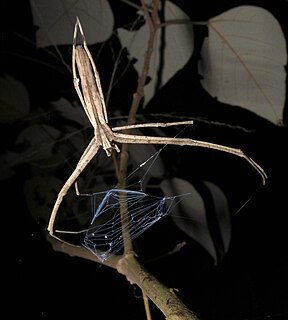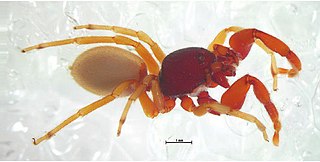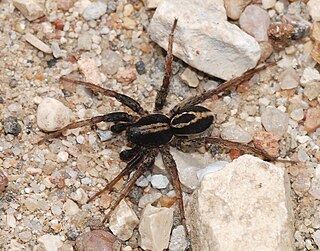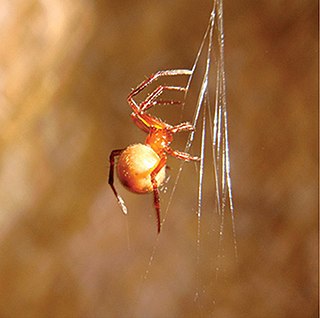Related Research Articles

Uloboridae is a family of nonvenomous spiders, known as cribellate orb weavers or hackled orb weavers. Their lack of venom glands is a secondarily evolved trait. Instead, they wrap their prey thoroughly in silk, cover it in regurgitated digestive enzymes, and then ingest the liquified body.

Deinopidae, also known as net casting spiders, is a family of cribellate spiders first described by Carl Ludwig Koch in 1850. It consists of stick-like elongated spiders that catch prey by stretching a web across their front legs before propelling themselves forward. These unusual webs will stretch two or three times their relaxed size, entangling any prey that touch them. The posterior median eyes have excellent night vision, allowing them to cast nets accurately in low-light conditions. These eyes are larger than the others, and sometimes makes these spiders appear to only have two eyes. Ogre-faced spiders (Deinopis) are the best known genus in this family. The name refers to the perceived physical similarity to the mythological creature of the same name. This genus also includes the humped-back spiders (Menneus).

Crevice weaver spiders (Filistatidae) comprise cribellate spiders with features that have been regarded as "primitive" for araneomorph spiders. They are weavers of funnel or tube webs. The family contains 18 genera and more than 120 described species worldwide.

Spider taxonomy is that part of taxonomy that is concerned with the science of naming, defining and classifying all spiders, members of the Araneae order of the arthropod class Arachnida with about 46,000 described species. However, there are likely many species that have escaped the human eye to this day, and many specimens stored in collections waiting to be described and classified. It is estimated that only one third to one half of the total number of existing species have been described.

Norman I. Platnick is an American biological systematist and arachnologist. He is a Professor Emeritus of the Richard Gilder Graduate School and Peter J. Solomon Family Curator Emeritus of the invertebrate zoology department of the American Museum of Natural History. A 1973 Ph.D. recipient at Harvard University, Platnick has described over 1,800 species of spiders from around the world, making him the second most prolific arachnologist in history, behind only Eugène Simon. Until 2014 he was also the maintainer of the World Spider Catalog, a website formerly hosted by the AMNH which tracks the arachnology literature, and attempts to maintain a comprehensive list, sorted taxonomically, of every species of spider which has been formally described. In 2007 he received the International Society of Arachnology's Bonnet award, named for Pierre Bonnet, in recognition for his work on the catalog.

Austrochilidae is a small spider family with ten species in three genera. Austrochilus and Thaida are endemic to the Andean forests of central and southern Chile and adjacent Argentina, while Hickmania is endemic to Tasmania. The monophyly of the family and the relationships among the genera are uncertain as of May 2017.

The Dionycha are a clade of spiders (Araneomorphae:Entelegynae), characterized by the possession of two tarsal claws with tufts of hairs (setae) beside them, which produce strong adhesion, enabling some species to climb glass. The circumscription of the group has varied widely; a 2014 analysis resulted in about 20 families, including Salticidae, Thomisidae, and Clubionidae. Spiders in this group have better senses than others, some even show courtship dances and songs.

Lycosoidea is a clade or superfamily of araneomorph spiders. The traditional circumscription was based on a feature of the eyes. The tapetum is a reflective layer at the back of the eye, thought to increase sensitivity in low light levels. Lycosoids were then defined by having a "grate-shaped" tapetum. Research from the late 1990s onwards suggests that this feature has evolved more than once, possibly as many as five times, so that the original Lycosoidea is paraphyletic. Studies published in 2014 and 2015 suggest that a smaller group of families does form a clade.

The Palpimanoidea or palpimanoids, also known as assassin spiders, are a group of araneomorph spiders, originally treated as a superfamily. As with many such groups, its circumscription has varied. As of September 2018, the following five families were included:

The Dysderoidea are a clade or superfamily of araneomorph spiders. The monophyly of the group, initially consisting of the four families Dysderidae, Oonopidae, Orsolobidae and Segestriidae, has consistently been recovered in phylogenetic studies. In 2014, a new family, Trogloraptoridae, was created for a recently discovered species Trogloraptor marchingtoni. It was suggested that Trogloraptoridae may be the most basal member of the Dysderoidea clade. However, a later study found that Trogloraptoridae was placed outside the Dysderoidea and concluded that it was not part of this clade.

The spider genus Spintharus occurs from the northeastern United States to Brazil. Nicholas Marcellus Hentz circumscribed the genus in 1850, initially as a monospecific genus containing his newly described species S. flavidus.

The Department of Entomology is a research department and collection unit of the Smithsonian Institution's National Museum of Natural History (NMNH), located in Washington, DC. The department houses the U.S. National Insect Collection, one of the largest entomological collections in the world, with over 35 million specimens housed in 132,354 drawers, 33,000 jars or vials, and 23,000 slides in more than 5,200 cabinets. The department also includes research scientists and technical staff from the Smithsonian Institution, the United States Department of Agriculture Systematic Entomology Lab (SEL) and United States Department of Defense Walter Reed Biosystematics Unit (WRBU).

The RTA clade is a clade of araneomorph spiders, united by the possession of a retrolateral tibial apophysis – a backward-facing projection on the tibia of the male pedipalp. The clade contains over 21,000 species, almost half the current total of about 46,000 known species of spider. Most of the members of the clade are wanderers and do not build webs.

Udubidae is a family of araneomorph spiders, most of whose members were formerly placed in the family Zorocratidae, which is no longer accepted.
Zorodictyna is a genus of spiders in the family Udubidae native to Madagascar. It has been described as an intermediate genus between Zoropsidae and Dictynidae, though it is now placed in Udubidae. This genus was originally placed in the family Zoropsidae, but it has been reassigned several times since. In 1967, Lehtinen moved it to Miturgidae. In 1999, it was moved back to Zoropsidae, and in 2015, it was moved to Udubidae.
Campostichomma is a genus of spiders in the Udubidae family native to Sri Lanka. Many of its species were moved to either Griswoldia or Devendra. This genus was originally placed in the Agelenidae family. It was moved to Miturgidae in 1967, to Zoropsidae in 1999, then to Udubidae in 2015.
The Walter Reed Biosystematics Unit ("WRBU") is a US Army organization that conducts laboratory and field research on the systematics of medically important arthropods in support of epidemiological investigations and disease prevention and control strategies of importance to the military. Research is carried out worldwide, within geographic or faunistic restrictions of the material available and military requirements. Research efforts focus on the development of accurate and reliable means of identifying vectors of arbopathogens of humans.
Marek Michał Żabka is a Polish arachnologist.

Plato is a genus of ray spider. The American biologist Jonathan A. Coddington named and circumscribed the genus in 1986. It is a Neotropical genus and it is limited to South America. As of 2018, nine species are recognized. They are found in caves and have a distinctive cubic egg sac. The generic name comes from the ancient Greek philosopher Plato.
Baalzebub is a genus of ray spiders first described by Jonathan A. Coddington in 1986.
References
- 1 2 3 "SI Entomology Staff : Jonathan A. Coddington". Department of Entomology, National Museum of Natural History. Archived from the original on 2015-09-05. Retrieved 2015-10-17.
- ↑ "Search Bibliography for 'Coddington'", World Spider Catalog, Natural History Museum Bern, retrieved 2015-10-17
| This article about a biologist from the United States is a stub. You can help Wikipedia by expanding it. |